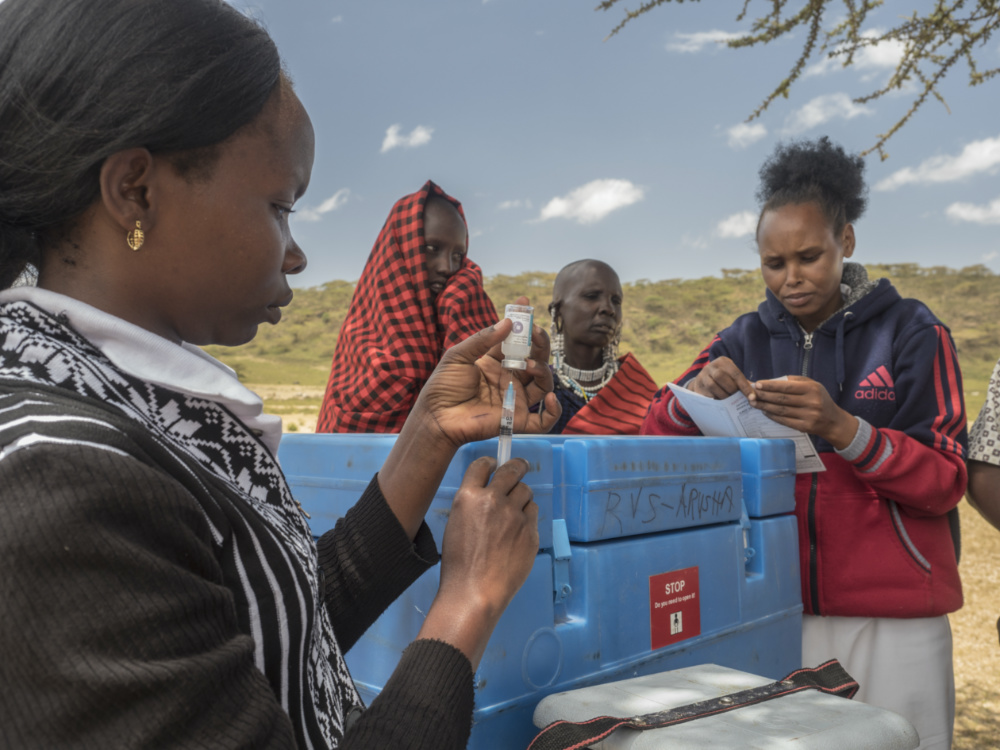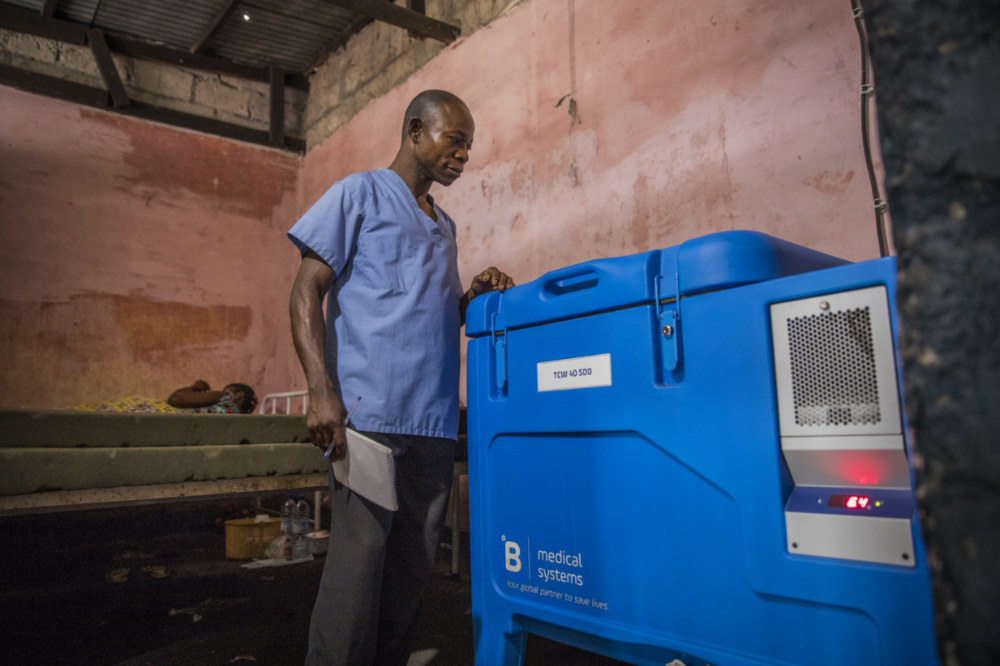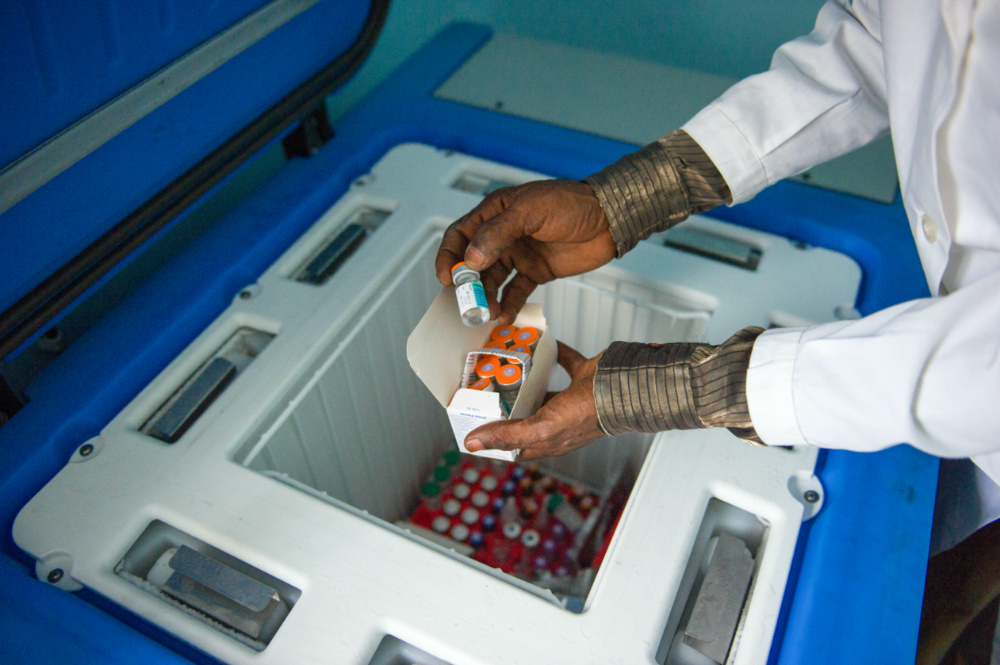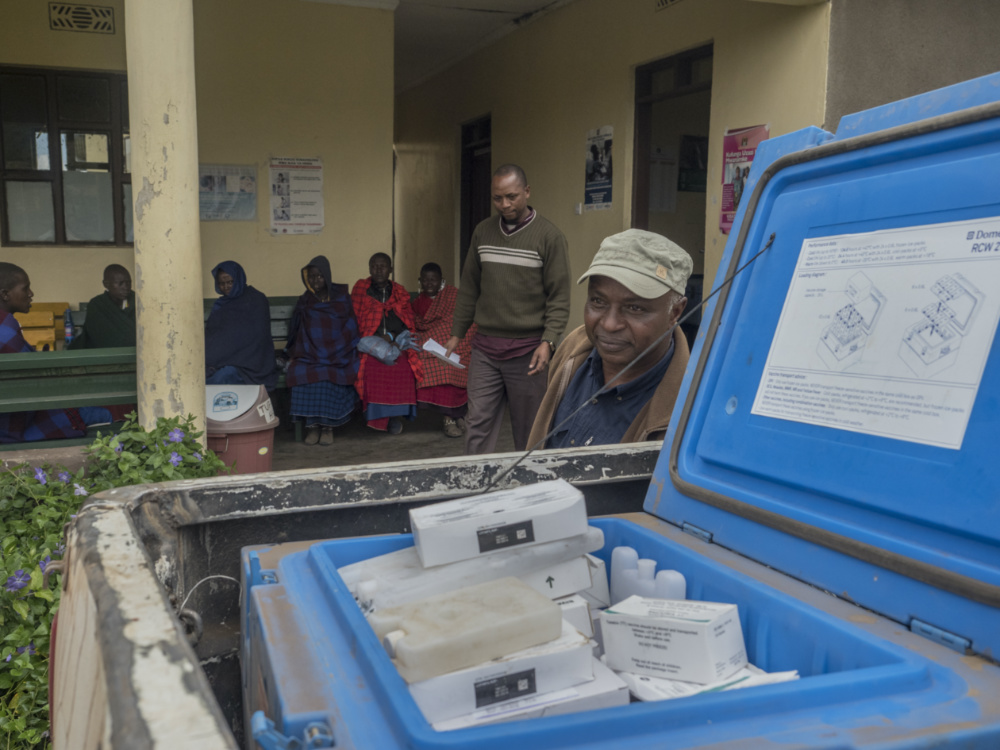
As the development of COVID-19 vaccines gains pace, PEYTON FLEMING, writing for Thomson Reuters Foundation, looks at the challenge of providing proper refrigeration when it comes time for distribution in Africa…
Boston, US
Thomson Reuters Foundation
Dozens of children at a clinic in North Kivu, on the eastern border of the Democratic Republic of Congo, received a measles vaccine in May, made possible by a quiet revolution in refrigeration that keeps vaccines cold, even in places without reliable electric power.
The “solar direct-drive” refrigerators – plain, box-like coolers that do not require fuel or batteries – have helped boost child vaccinations in DRC’s poorest rural provinces by 50 per cent in the past year, according to global vaccine alliance Gavi.
That has helped cut child mortality in DRC to half of what it was two decades ago. More than 18 million children were vaccinated last year against a deadly measles outbreak, which has slowed dramatically in recent weeks.
Now the world is looking to launch a far bigger immunisation push once vaccines for COVID-19 become available.

At an outreach post, Masasai people in the mountains – far away from any health centre – are vaccinated and recorded in the Electronic Immunisation Register by Dr Shemaghembe Bakeri in the Ngorongoro conservation area, Kiragarieni, Tanzania, on 4th October, 2018. PICTURE: Handout/Herve Lequeux/GAVI
Delivering millions of inoculations in Africa, a sprawling continent with fragile health systems and a lack of electricity to power them, will be a daunting task.
And it remains unclear whether existing off-grid fridges can keep the vaccines cold enough to help.
“It’s probably the biggest logistical challenge the world has ever faced, and it’s an especially immense challenge for sub-Saharan African countries with significant rural populations.”
– Toby Peters, a professor specialising in cooling systems for food and medicine at Britain’s University of Birmingham.
Refrigeration is essential for vaccine distribution.
Most vaccines require cooling at between two and eight degrees Celsius (35-46 degrees Fahrenheit), but nearly half of the leading COVID-19 vaccine candidates under development will require cold storage as low as minus 80 degrees, researchers say.
In addition, a cold chain distribution network for COVID-19 vaccines will require seamlessly low temperatures from manufacturers to airports to remote rural villages.
Despite advances that have likely saved millions of lives by keeping vaccinations cold in recent years, most African countries still have enormous gaps in such networks.
“It’s probably the biggest logistical challenge the world has ever faced, and it’s an especially immense challenge for sub-Saharan African countries with significant rural populations,” said Toby Peters, a professor specialising in cooling systems for food and medicine at Britain’s University of Birmingham.

A nurse handles vaccines from a brand new solar fridge in a newly opened health centre in the village of Mbankana, some 150 kilometres from Kinshasa, in the Democratic Republic of Congo on 28th April, 2015. PICTURE: Handout/GAVI/Phil Moore
When William Clemmer, a doctor with faith-based non-profit IMA World Health, arrived in the DRC in the 1990s, many health centres were using outdated kerosene-powered refrigerators that would often break down, damaging or destroying vaccines.
First-generation solar refrigerators were an improvement, but they required storage batteries that often stopped working after two to three years and were hard to replace.
Solar direct-drive refrigerators changed that, starting about a decade ago.
Costing between $US3,500 and $US9,000, they are wired directly to solar photovoltaic panels, which provide thermal energy to freeze a thick lining of water, with the ice layer keeping the vaccines inside cool for many days, no matter the weather.
In 2016, only 16 per cent of DRC’s rural health centers had working refrigerators, according to Gavi.
A D V E R T I S E M E N T
{subscriber-ad}
Today close to 80 per cent are equipped, many with direct-drive solar units. They have enabled 24,000 monthly immunisation sessions in the nine poorest provinces in the past year, a 50 per cent jump from 2018.
“They’ve essentially revolutionised vaccine delivery for children in sub-Saharan Africa,” said Clemmer.
Karan Sagar, a doctor who heads the health systems and immunisations strengthening team at Gavi, credits the off-grid equipment for achieving a 25 per cent jump in child vaccination rates in Africa from a decade ago.
Since 2017, a $US250-million effort led by Gavi has delivered more than 15,300 solar direct-drive fridges to three-dozen African countries, including nearly 3,400 units to the DRC and 5,400 to Nigeria.
Sagar said 87 per cent of children in those African countries received the first dose of a vaccine last year for diphtheria, tetanus and pertussis (whooping cough).
“This is a testament to the ability of supply chains to reach even the most remote communities in the world,” he said.

A medical staffer stands next to a solar-powered refrigerator used to keep vaccines cold in the Democratic Republic of Congo, on 12th October, 2018. PICTURE: Handout/GAVI/Thomas Nicolon
It is not only ultra-cold temperatures for COVID-19 vaccines that Africa may need to contend with.
Solar refrigerators are only the last of many steps that will be required to move the vaccines quickly and safely from centralized manufacturing sites – whether inside or outside Africa – to urban and rural destinations across the continent.
At every step along the way – airplanes, warehouses, trucks, motorbikes, bicycles, canoes and even drones – the vaccines must be kept at specific, very cold temperatures, just like other perishable products.
And substantially larger volumes will be needed.
While child vaccination campaigns typically reach about 115 million infants annually worldwide, the COVID-19 vaccine will need to reach as many as 750 million people in Africa alone, health experts predict.
While child vaccination campaigns typically reach about 115 million infants annually worldwide, the COVID-19 vaccine will need to reach as many as 750 million people in Africa alone, health experts predict.
To prepare for this challenge, cold chain expert Peters is leading a government-backed effort to evaluate Africa’s needs in delivering an eventual COVID-19 vaccine, working with non-profit, commercial and academic partners.
They are drawing on lessons from Rwanda, a central-east African country that has made enormous progress in recent years building efficient, climate-friendly cold chains for food and vaccine delivery.
Its system evolves around one warehouse that serves as a cooling hub for vaccines that are distributed to district hospitals, health centres and remote rural health posts, of which dozens are using solar fridges.
The vaccines are reaching more than 95 per cent of the population, according to the World Health Organization.
But replicating Rwanda’s success will be a formidable task. “Rwanda is small – countries like Nigeria are much more difficult,” Peters said.

Vaccines being kept cool at a health centre based in the Ngorongoro conservation area, Tanzania. PICTURE: Handout by Herve Lequeux/GAVI
Food cold chains where larger-scale commercial capacity is more established will be the kind of model needed, he added.
“We know how to move hundreds of millions of tonnes of fresh food from small farms across Africa to the fridges of consumers in Europe,” Peters said. “We need to take this expertise and transfer it to vaccines.”
But that is before factoring in the potential ultra-cooling needs COVID-19 vaccines may require – which solar direct-drive fridges are typically not equipped to handle.
Rwanda and the DRC do have firsthand experience of vaccines needing ultra-cold storage in the form of a new vaccine that helped end the Ebola outbreak this past summer.
“Super thermos” coolers, filled with blocks of synthetic alcohol ice, kept the vaccine at minus 60 to 80 degrees for up to 6.5 days. But the amounts involved were a tiny fraction of what would be needed for an effective COVID-19 vaccine.
“Few African economies have any ultra-cold chain capacity at all,” Sagar noted.
Peters is hoping COVID-19 vaccines will require only the standard cold storage at two to eight degrees Celsius, which solar direct-drive refrigerators can provide at rural health centres.
“If mainstream cold chains have to get below that, we have a massive new challenge,” he said.






